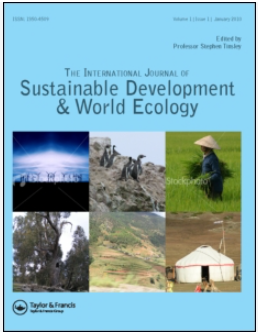2019冠状病毒病疫情期间影响城市网络结构弹性的因素有哪些?在中国的比较分析
IF 7.7
3区 环境科学与生态学
Q1 ECOLOGY
International Journal of Sustainable Development and World Ecology
Pub Date : 2022-08-09
DOI:10.1080/13504509.2022.2108928
引用次数: 1
摘要
新冠肺炎疫情下,城市网络结构韧性已成为社会经济稳定复苏的重要保障。本文选取人口流动数据和货运需求信息构建城市网络。从网络结构的多样性、均衡性、互惠性、协调性和传递性五个方面,用复杂网络来描述发展水平。基于发展水平的描述,采用熵权TOPSIS法计算城市网络的结构弹性。研究发现,随着疫情的增加,人口流动网络和货运需求网络的结构呈现出从“单中心”到“双中心”再到“多中心”的演化趋势。同时,扁平的网状结构有利于提高结构的弹性。因为多样性对人口流动网络和货运需求网络结构弹性的影响分别为0.541和0.142,而均衡的影响分别为0.440和0.769。多样性和均衡性高的网络往往形成扁平结构,表现出更强的弹性。此外,人口流动网络中的“远程链接”和货运需求网络中的“不平衡转移”现象也有助于提高网络的结构弹性。因此,城市可以通过多中心建设和跨区域合作建立扁平化网络,在提高城市网络异质性的同时,也要促进网络的全方位、多面性发展。本文章由计算机程序翻译,如有差异,请以英文原文为准。
What factors affect the structural resilience of urban networks during COVID-19 epidemic? A comparative analysis in China
ABSTRACT Under the COVID-19 epidemic, the structural resilience of urban networks has become an important guarantee for social and economic stability and recovery. In this study, population mobility data and freight demand information are selected to construct urban networks. The complex network is used to describe the development level from five aspects of diversity, equilibrium, reciprocity, assortativity and transmission of network structure. And the entropy weight TOPSIS method is used to calculate the structural resilience of urban network based on the description of development level. We find that as the epidemic increases, the structure of population mobility network and freight demand network shows an evolutionary trend from ‘single-center’ to ‘dual-center’, and then to ‘polycentric’. Meanwhile, a flat network structure is conducive to higher structural resilience. Because the impact of diversity on the structural resilience of population mobility network and freight demand network is respectively 0.541 and 0.142, while the impact of equilibrium is respectively 0.440 and 0.769. The network with high diversity and equilibrium tends to form flat structure and show stronger resilience. Besides, the ‘long-range link’ in the population mobility network and the phenomenon of ‘imbalance transfer’ in the freight demand network can also help to improve the structural resilience of the network. Therefore, cities can establish a flat network through polycentric construction and cross-regional cooperation, while improving the heterogeneity of the urban network, they should also promote all-round and multi-faceted development of the network.
求助全文
通过发布文献求助,成功后即可免费获取论文全文。
去求助
来源期刊
CiteScore
11.10
自引率
3.60%
发文量
58
审稿时长
18-36 weeks
期刊介绍:
The International Journal of Sustainable Development and World Ecology is now over fifteen years old and has proved to be an exciting forum for understanding and advancing our knowledge and implementation of sustainable development.
Sustainable development is now of primary importance as the key to future use and management of finite world resources. It recognises the need for development opportunities while maintaining a balance between these and the environment. As stated by the UN Bruntland Commission in 1987, sustainable development should "meet the needs of the present generation without compromising the ability of future generations to meet their own needs."

 求助内容:
求助内容: 应助结果提醒方式:
应助结果提醒方式:


